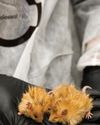SO, WHAT IS A PRIMATE?
April 2024
|Muse Science Magazine for Kids
What do you have in common with the aye-aye, sifaka, siamang, and potto? If you said your collarbone, you re probably a primatologist—a person who studies primates. If you’re not, read on.

Physical Adaptations and Abilities
Just like those animals with the weird names, you belong to the group of mammals called primates. This group also includes the more commonly known gorillas, chimpanzees, and monkeys. Among other things, it’s the structure of your shoulder that earns you membership in that club. In primates, the upper arms are linked to the chest by the collarbone (also called the clavicle). That construction allows you and other primates to do something most mammals can’t: hang by your arms. Watch kids crossing a jungle gym hand-over-hand. They share that ability with monkeys and apes, but don’t expect rabbits, goats, or bears to perform such a feat!
The ability to swing isn’t the only adaptation to life in the trees, where most primates live. Eyes face forward, encased in bony sockets. That lets the view from one eye overlap the other. The result is 3D (three-dimensional) or stereoscopic vision—the perfect tool for judging both depth and distance.

Primates have agile arms and legs. Apes have no tails, but monkeys use their long, flexible tails for balance. Many New World monkeys have prehensile tails that wrap around branches and act as an extra hand or foot. Some can support their entire weight using only their tails.
هذه القصة من طبعة April 2024 من Muse Science Magazine for Kids.
اشترك في Magzter GOLD للوصول إلى آلاف القصص المتميزة المنسقة، وأكثر من 9000 مجلة وصحيفة.
هل أنت مشترك بالفعل؟ تسجيل الدخول
المزيد من القصص من Muse Science Magazine for Kids

Muse Science Magazine for Kids
ANIMAL FIREFIGHTER TO THE RESCUE
Can animals help manage the risks of deadly wildfires?
3 mins
Muse July 2025: The Story Behind Wildfires

Muse Science Magazine for Kids
FIRE DANGER
WHY THE RISK OF WILDFIRES KEEPS GROWING
4 mins
Muse July 2025: The Story Behind Wildfires

Muse Science Magazine for Kids
The Miller NEW Normal
WHAT TODAY’S WILDFIRES TELL US ABOUT OUR FUTURE
8 mins
Muse July 2025: The Story Behind Wildfires

Muse Science Magazine for Kids
WOMEN AND FIREFIGHTING: A GOOD FIT
Jessica Gardetto is a firefighter. Her father was, too. “I grew up with my dad coming home smelling like wildfire and covered in soot,” she says.
1 min
Muse July 2025: The Story Behind Wildfires

Muse Science Magazine for Kids
What is happening on your fingertips when they get all wrinkly in a hot tub?
—Felix G., age 10, Montana
1 mins
Muse July 2025: The Story Behind Wildfires

Muse Science Magazine for Kids
WHEN the SMOKE CLEARS
THE LINGERING EFFECTS OF THE RECENT PACIFIC PALISADES AND ALTADENA EATON FIRES
6 mins
Muse July 2025: The Story Behind Wildfires

Muse Science Magazine for Kids
PICKING TEAMS
Keep it fair with a strategy that relies on geometry.
2 mins
Muse July 2025: The Story Behind Wildfires

Muse Science Magazine for Kids
SHAN CAMMACK
WILDLIFE BIOLOGIST AND FIRE SAFETY OFFICER
3 mins
Muse July 2025: The Story Behind Wildfires

Muse Science Magazine for Kids
Scientists Create Mice With Woolly Mammoth-Like Fur
RESEARCHERS AT A COMPANY IN TEXAS ARE WORKING TO CREATE A LIVING ANIMAL THAT RESEMBLES THE EXTINCT WOOLLY MAMMOTH. Recently, they produced mice with traits of the large mammal. The mice all have coats with mammoth-like fur, and some of the small mammals also have genes that help them store fat. Both features would help the animals survive in the cold Arctic, where the woolly mammoth once lived.
1 min
Muse July 2025: The Story Behind Wildfires

Muse Science Magazine for Kids
Cool Sunshade Added to the Nancy Roman Space Telescope
THE NANCY ROMAN SPACE TELESCOPE IS A NEW TELESCOPE THAT NASA IS BUILDING AND WILL LAUNCH INTO SPACE, LIKELY IN EARLY 2027.
1 min
Muse July 2025: The Story Behind Wildfires
Listen
Translate
Change font size

